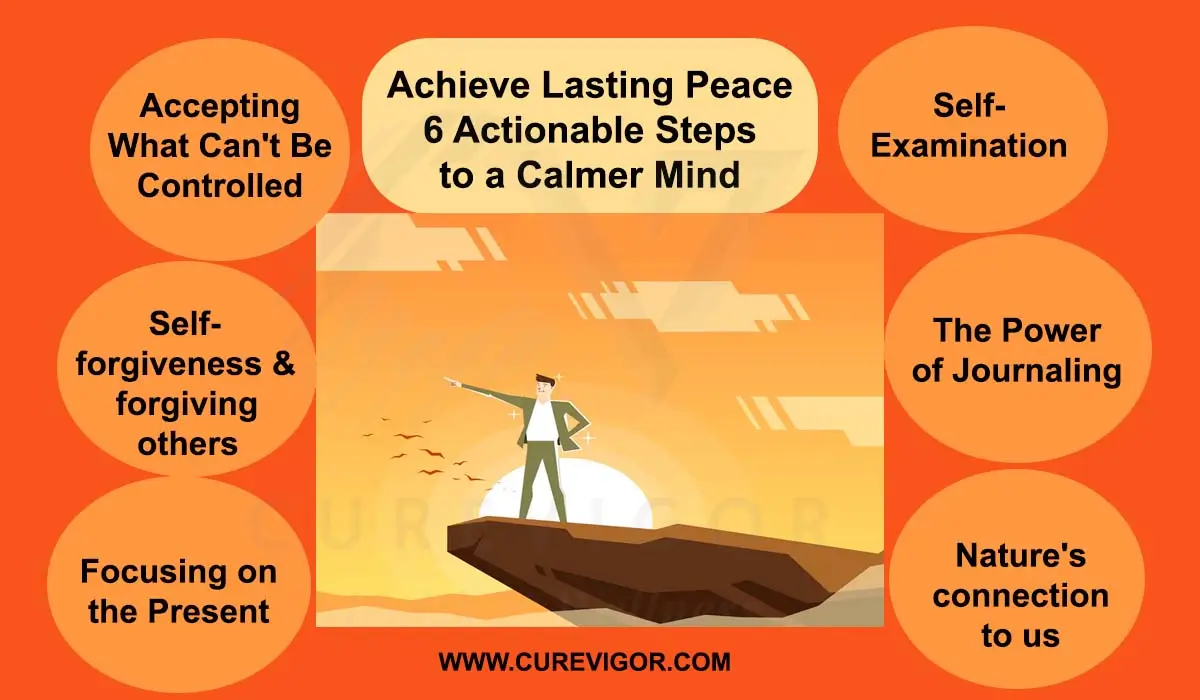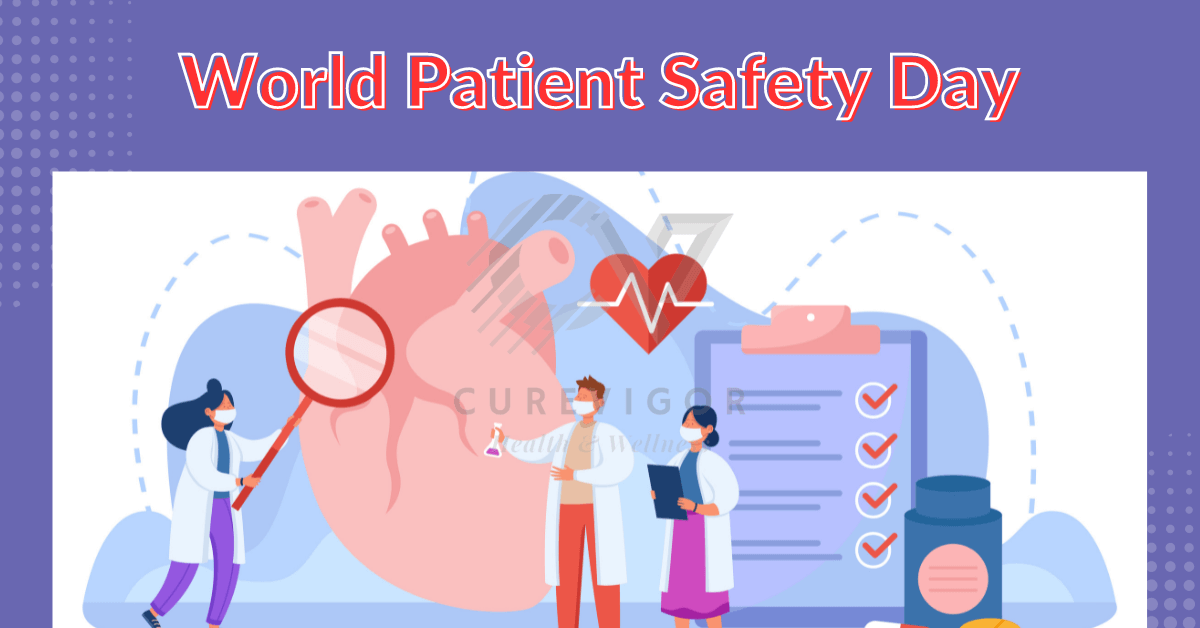Discover six actionable steps for lasting peace and a calmer mind: accept what can’t be controlled, forgive, stay present, connect with your inner self, journal, and embrace nature. Start your journey to serenity today!
Contents
- 1 How to Achieve Lasting Peace
- 1.1 1. Accepting What Can’t Be Controlled
- 1.2 2. Self-forgiveness and forgiving others
- 1.3 Steps to Practice Forgiveness
- 1.4 Benefits of Forgiveness
- 1.5 3. Focusing on the Present
- 1.6 4. Self-examination
- 1.7 5. The Power of Journaling
- 1.8 Writing Down Your Ideas and Feelings
- 1.9 6. Nature’s connection to us
- 1.10 Conclusion on Achieving Inner Peace
- 1.11 FAQs on Achieving Inner Peace
How to Achieve Lasting Peace
Finding peace and calm can feel like chasing the wind in today’s fast-paced world. But what if I told you that achieving a calmer mind is within your reach? You can cultivate lasting peace and transform your mental well-being by following six actionable steps. Let’s dive into these steps and discover how to start your journey to a more serene life.
In today’s hurried world, finding peace of mind often feels elusive, but it’s more attainable than you might think. You can cultivate a sense of calm and inner peace by making small shifts in your mindset and daily habits. Here are several ways to achieve that:
1. Accepting What Can’t Be Controlled
One of the most significant sources of inner turmoil is the desire to control things outside our reach. Recognizing that certain things are beyond our control is critical to peace of mind, whether it’s other people’s actions, unforeseen events, or the past. Acceptance doesn’t mean resignation; it means understanding that fighting against what cannot be changed only drains our energy. By letting go of the need for control, you free up mental space to focus on what truly matters—your actions, reactions, and attitudes.
Techniques for Releasing Control
Start by identifying what you can and cannot control. Make a list and consciously focus on the elements you have power over. Practice breathing exercises and mindfulness to help release the need for control. Remember, letting go is not about giving up but finding peace in acceptance.
2. Self-forgiveness and forgiving others
Carrying grudges or guilt places an unnecessary burden on the mind. Forgiveness, both for yourself and others, is like lifting a heavy weight off your shoulders. When you forgive, you aren’t condoning harmful behaviour; instead, you release its emotional hold on you. Forgiving yourself is equally essential for peace. We all make mistakes, but dwelling on them prevents growth and healing. Learning from errors, offering yourself compassion, and moving forward without self-judgment opens the door to inner serenity.
Steps to Practice Forgiveness
Begin by acknowledging your feelings and understanding why you are hurt. Please write a letter to yourself or the person you must forgive (you don’t have to send it). Place yourself in the other person’s shoes to cultivate empathy. Finally, make a conscious decision to let go and move forward.
Benefits of Forgiveness
Forgiveness promotes mental clarity, decreases blood pressure, and reduces stress. It allows you to live in the present, unburdened by past grievances.
3. Focusing on the Present
The Essence of Mindfulness
The discipline of mindfulness involves being present in the moment. It entails objectively observing one’s thoughts, emotions, and environment.
Mindfulness Practices to Stay Present

Incorporate mindfulness into your daily routine with simple practices like mindful breathing, body scans, and mindful eating. Every day, set aside some time to sit still and concentrate on your breathing.
How to Handle Distractions
When you become distracted, remember to refocus your attention on the present moment. To maintain your mindfulness practice, use techniques such as grounding exercises or repeating a mantra.
The mind tends to wander to the past or worry about the future, often causing stress. Staying present is one of the most powerful tools for maintaining peace of mind. By focusing on what’s happening in the here and now, you can appreciate life as it unfolds, free from the anxieties of the unknown or the regrets of the past. Simple mindfulness techniques—like focusing on your breath, observing your surroundings, or practising gratitude for the current moment—can bring you back to the present and centre your thoughts.
4. Self-examination
Exploring Self-Reflection
Self-reflection involves delving deep into one’s inner world to examine thoughts, feelings, and actions to better understand oneself.
Methods to Connect with Your Inner Self
Spend time alone in a quiet place where you can think without interruption. Ask yourself meaningful questions and listen to your inner voice. Visualization and meditation might also support your inner self-connection.
The Role of Meditation
The power of meditation lies in its ability to facilitate inner exploration. It helps quiet the mind and allows you to tune into your inner wisdom. Start with guided meditations or simple, breath-focused sessions.
5. The Power of Journaling
The Benefits of Journaling
Maintaining a journal is a therapeutic tool that facilitates emotional processing and cognitive awareness. It can reduce stress, enhance self-awareness, and promote emotional healing.
How to Start Journaling
Start by designating a certain period for writing each day. Choose a comfortable and quiet spot, and start with a few minutes of free writing. Let your thoughts flow, and don’t bother about spelling or punctuation.
Writing Down Your Ideas and Feelings
Writing down your thoughts and emotions is a therapeutic way to process what’s on your mind. Journaling allows you to express feelings that may be difficult to voice, helping to reduce mental clutter. By putting pen to paper, you can release pent-up emotions, make sense of your thoughts, and gain insight into your feelings.
It’s also an excellent tool for tracking your mood or behaviour patterns, enabling you to understand yourself better. Over time, journaling can foster self-awareness and emotional growth, leading to a more peaceful state of mind.
Prompts for Effective Journaling
Use prompts to guide your journaling sessions. Questions like “What am I grateful for today?” or “What challenges did I face and how did I overcome them?” can help you delve deeper into your emotions.
6. Nature’s connection to us
The Healing Power of Nature
Spending time in nature has a grounding effect on the mind and body. Whether it’s a walk in the park, sitting by the ocean, or tending to a garden, connecting with the natural world helps to restore balance. Outdoors can reduce stress, calm your nervous system, and enhance your mood. Nature reminds us of the beauty and simplicity of life, encouraging us to slow down and breathe. Feeling the earth beneath your feet, observing wildlife, or listening to the sounds of nature can help you feel more connected to the world around you, bringing a sense of peace and belonging.
Activities to Connect with Nature
Take up hiking, gardening, or park strolling. Walking barefoot on grass or sand can bring you closer to the earth.
Creating a Routine to Stay Grounded
Make it a habit to spend time in nature regularly. Create a routine that includes outdoor activities, and stick to it. Even a few minutes each day can make a significant difference.
Conclusion on Achieving Inner Peace
Achieving lasting peace and a calmer mind is a journey that requires dedication and practice. You can cultivate a serene and peaceful mind by accepting what you can’t control, forgiving yourself and others, staying present, going within, journaling, and connecting to nature. Remember, the journey to a calmer mind is personal and unique to each individual. Take small steps, be patient with yourself, and enjoy the process.
FAQs on Achieving Inner Peace
Q. What are the steps to achieving peace?
To achieve peace, follow these steps:
- Accept What Can’t Be Controlled: Let go of things beyond your control.
- Forgive yourself and others. Release grudges and resentment.
- Remain Aware of the Present Moment: Practice mindfulness.
- Go Within: Engage in self-reflection and meditation.
- Journal Your Thoughts and Emotions: Use journaling for emotional processing.
- Connect to Mother Earth: Spend time in nature and practice grounding.
Q. How do we achieve peace of mind?
Achieving peace of mind involves:
- Practicing mindfulness: Stay present and aware.
- Managing stress: Use relaxation techniques like deep breathing and meditation.
- Letting Go of Control: Accept things you can’t change.
- Maintaining a Healthy Lifestyle: Exercise regularly and eat a balanced diet.
- Building Positive Relationships: Surround yourself with supportive people.
Q. How can we achieve peace and stability of mind?
To achieve peace and stability of mind:
- Adopt a Consistent Routine: Establish regular habits for stability.
- Practice meditation and mindfulness. Cultivate awareness and calmness.
- Set realistic goals. Avoid overloading yourself with unrealistic expectations.
- Develop Coping Strategies: Learn techniques to handle stress effectively.
- Stay Connected with Nature: Spend time outdoors to rejuvenate your mind.
Q. How do you get peace and calm?
To get peace and calm:
- Engage in regular meditation. Quiet your mind and find inner peace.
- Practice deep breathing exercises to calm your nervous system.
- Spend Time in Nature: Connect with the natural world for relaxation.
- Simplify Your Life: Declutter and focus on what truly matters.
- Exercise Gratitude: Pay attention to the blessings in your life.
Q. What are the 7 keys to peace of mind?
The 7 keys to peace of mind are:
- Acceptance: Embrace what you cannot change.
- Forgiveness: Let go of past hurts.
- Mindfulness: Stay present in the moment.
- Self-Reflection: Understand your inner self.
- Journaling: Express your thoughts and emotions.
- Nature Connection: Spend time outdoors.
- Healthy Living: Maintain physical health with good habits.
Q. How do I have a calm mind?
To have a calm mind:
- Practice Regular Meditation: Dedicate time daily to meditate.
- Engage in Mindfulness Activities: Focus on the present moment.
- Exercise regularly. Physical activity helps reduce stress.
- Create a Peaceful Environment: Surround yourself with a calming space.
- Minimize stressors: recognize and lessen the sources of tension in your life.
- Use Relaxation Techniques: Try yoga, deep breathing, or progressive muscle relaxation.
Read more articles on Health and Wellness.
You might like to read:










